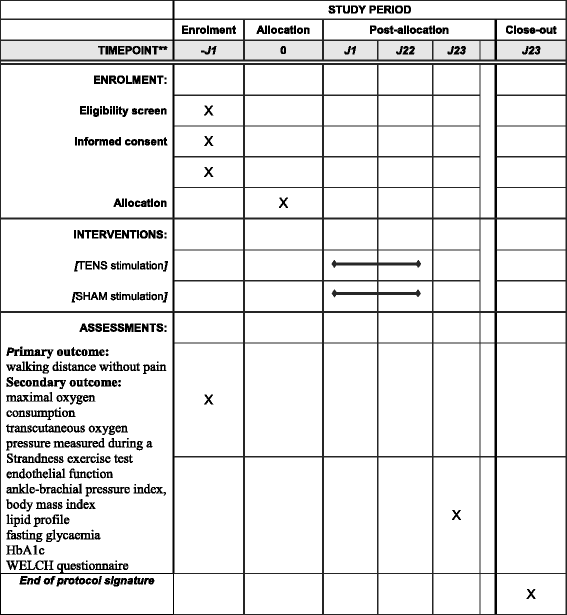The efficacy of transcutaneous electrical nerve stimulation on the improvement of walking distance in patients with peripheral arterial disease with intermittent claudication: study protocol for a randomised controlled trial: the TENS-PAD study
- PMID: 28797281
- PMCID: PMC5553808
- DOI: 10.1186/s13063-017-1997-1
The efficacy of transcutaneous electrical nerve stimulation on the improvement of walking distance in patients with peripheral arterial disease with intermittent claudication: study protocol for a randomised controlled trial: the TENS-PAD study
Abstract
Background: In patients with peripheral arterial disease (PAD), walking improvements are often limited by early pain onset due to vascular claudication. It would thus appear interesting to develop noninvasive therapeutic strategies, such as transcutaneous electrical nerve stimulation (TENS), to improve the participation of PAD patients in rehabilitation programmes, and thus improve their quality of life. Our team recently tested the efficacy of a single 45-min session of 10-Hz TENS prior to walking. TENS significantly delayed pain onset and increased the pain-free walking distance in patients with class-II PAD. We now seek to assess the efficacy of a chronic intervention that includes the daily use of TENS for 3 weeks (5 days a week) on walking distance in Leriche-Fontaine stage-II PAD patients.
Methods/design: This is a prospective, double-blind, multicentre, randomised, placebo-controlled trial. One hundred subjects with unilateral PAD (Leriche-Fontaine stage II) will be randomised into two groups (1:1). For the experimental group (TENS group): the treatment will consist of stimulation of the affected leg (at a biphasic frequency of 10 Hz, with a pulse width of 200 μs, maximal intensity below the motor threshold) for 45 min per day, in the morning before the exercise rehabilitation programme, for 3 weeks, 5 days per week. For the control group (SHAM group): the placebo stimulation will be delivered according to the same modalities as for the TENS group but with a voltage level automatically falling to zero after 10 s of stimulation. First outcome: walking distance without pain.
Secondary outcomes: transcutaneous oxygen pressure (TcPO2) measured during a Strandness exercise test, peak oxygen uptake (VO2 peak), endothelial function (EndoPAT®), Ankle-brachial Pressure Index, Body Mass Index, lipid profile (LDL-C, HDL-C, triglycerides), fasting glycaemia, HbA1c level, and the WELCH questionnaire.
Discussion: TENS-PAD is the first randomised controlled trial that uses transcutaneous electrical therapy as an adjuvant technique to improve vascular function in the treatment of PAD. If the results are confirmed, this technique could be incorporated into the routine care in cardiovascular rehabilitation centers and used in the long term by patients to improve their walking capacity.
Trial registration: ClinicalTrials.gov, ID: NCT02678403 . Registered on 9 February 2016.
Sponsor: Toulouse University Hospital.
Keywords: Endothelial function; Peripheral arterial disease; Physical activity; Transcutaneous electrical nerve stimulation.
Figures


References
-
- Norgren L, Hiatt WR, Dormandy JA, Nehler MR, Harris KA, Fowkes FG, Group TIW, Bell K, Caporusso J, Durand-Zaleski I, et al. Inter-society consensus for the management of peripheral arterial disease (TASC II) Eur J Vasc Endovasc Surg. 2007;33(Suppl 1):S1–75. doi: 10.1016/j.ejvs.2006.09.024. - DOI - PubMed
-
- Sigvant B, Wiberg-Hedman K, Bergqvist D, Rolandsson O, Andersson B, Persson E, Wahlberg E. A population-based study of peripheral arterial disease prevalence with special focus on critical limb ischemia and sex differences. J Vasc Surg. 2007;45:1185–91. doi: 10.1016/j.jvs.2007.02.004. - DOI - PubMed
Publication types
MeSH terms
Associated data
LinkOut - more resources
Full Text Sources
Other Literature Sources
Medical

